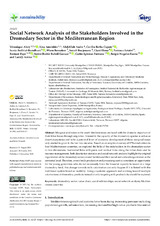Social Network Analysis of the Stakeholders Involved in the Dromedary Sector in the Mediterranean Region
Autor
Alary, Véronique
Amsidder, Lina
Araba, Abdelilah
Barba Capote, C.J.
Bedhiaf-Romdhani, Sonia
Bensalem, Wiem
Boujenane, Ismail
Ciani, Elena
Letaief, Neirouz
Faye, Neirouz
Gaouar, Semir Bechir Suheil
Iglesias Pastrana, Carlos
Nogales Baena, Sergio
Amine, Laridji
Editor
MDPIFecha
2021Materia
Dromedary sectorValue chain
Social relationships
Social network analysis
Mediterranean countries
METS:
Mostrar el registro METSPREMIS:
Mostrar el registro PREMISMetadatos
Mostrar el registro completo del ítemResumen
Marginal arid zones in the south Mediterranean are faced with the dramatic departure of their labor forces through migration. Interest in the capacity of the dromedary species to enhance desert ecosystems and to be a potential lever of economic development of these marginal zones only started to grow in the last two decades. Based on an empirical survey of 179 stakeholders in four Mediterranean countries, we explored the links of the stakeholders in the dromedary sector in two dimensions: horizontal links with peers and vertical links along the value chain and in resource management. Both descriptive statistics and social network analysis highlight the original organization of the dromedary sector around herders and their social and cultural organization at the territorial level. Therefore, even if milk production and processing start to constitute an opportunity for the young generation who do not necessarily have the financial capacity to invest in a large dromedary herd, this change towards milk valorization can only happen if it is linked with the traditional system based on mobility. Using a systemic approach and working toward multiple valorizations of dromedary products instead of only targeting milk productivity should be explored.

